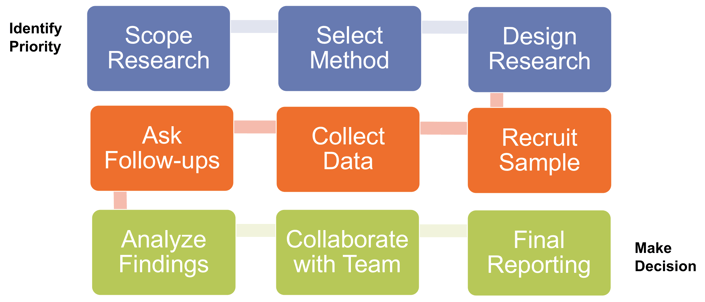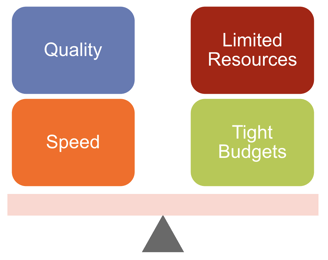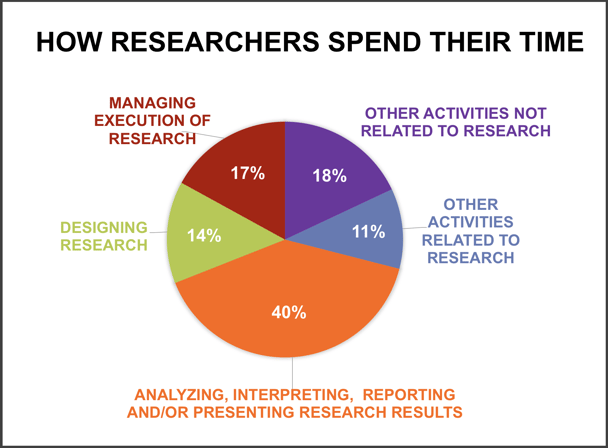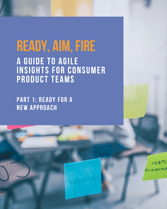Delivering high-quality market research takes a lot of expertise. Delivering agile research requires that expertise and more.
Think about all the steps involved in any given research project. Potential challenges are hidden along the way, like when you…
- Scope the research project… but the scope changes with new information.
- Select a preferred research method… but you don’t have the budget for it.
- Define your sample… but can’t easily recruit them.
- Analyze the data collected... but results are questioned, sending you back to square one.

Anybody can do fast research, but not everyone can do agile research. To succeed, you need to anticipate the speed bumps that might reduce your agility or cause you to sacrifice quality for speed. To point researchers in the right direction, we’ve compiled a list of the top five pitfalls encountered when conducting agile research that we’ve heard from all kinds of teams, as well as how to combat those challenges.
Pitfall 1: Focusing on speed versus agility.
This is very common, because when people think about agile research, they're focused on speed. But the speed is only about moving in one direction as fast as possible. It’s the ability to maneuver and adjust throughout the process without losing momentum that makes agile research propel us to faster decisions.
For example, some agile research platforms suggest that you can (and should) collect data within hours. But when you look at the people recruited, you realize that you only captured certain types of people who didn't happen to be working or at school during that timeframe. This practice may lead to the wrong decision because the group may only be a fraction of your target.
A more agile approach might be to set up and launch the study to run over the course of 24 hours. An agile research platform would let you see the results as they come in, so you can get an early read after just a few hours. But you would feel confident in your collection by the next day with a more representative target.
Pitfall 2: Getting stuck in a zero-sum game.
Sometimes it feels like organizations ask researchers to do the impossible. Projects will get thrown over the fence and you’ll be expected to come back with the answers overnight. Being agile means that instead of simply saying “no” to the project, you work together to figure out how to say “yes” in a way that delivers real value vs. quickly-collected garbage data.
For example, you can combine the concept of hitting milestones with a more collaborative approach to get real-time learnings. Rather than looking at a study as having to be designed, fielded and analyzed before you share findings, you can quite literally say:
“To move that fast, I’ll need to involve you every step of the way. You won’t have complete results, but we will look at results as they come in and discuss implications as the data is being collected. This way you can make some preliminary decisions, and nobody's caught off guard.”
This is where platforms with instant dashboard reporting, automated text analysis and the pinning of key quotes can really help. You can quickly pull up the dashboard with your team and answer their questions on the fly. Automated reporting gives you a head-start on any follow-up analysis, and lets you quickly build in iteration (you can read more on this in Pitfall 4). The final report becomes more about selling what the team collectively decided to leadership
When your team moves past “us vs. them" thinking, research becomes the guiding light that everyone wants, not the obstacle in getting approvals.
Pitfall 3: Making too many DIY sacrifices.

With limited resources and tight budgets, a DIY technology platform can sound like a great solution. But, if all you have for quant research is a survey platform, you won’t be achieving the standards for agile research. There's so much more to be done to inform solution-building than just asking people to rate things on a scale. For qual, there are so many options to get richer learning with greater efficiency than just DIY live or video interviews.
For example, the latest agile technology at Digsite allows you to talk to hundreds of qualified consumers to get their initial feedback, then dive deeper within a subset to have a group discussion, schedule live interviews, mark up concepts with comments or even capture a photo or video diary of their real experience. And you can follow-up with individual messages or clarifying questions so your team isn’t stuck if they learn something unexpected.
When you get more sophisticated agile technology that allows you to be flexible, it may leave your team wondering about the best way to answer their questions. This is where it is critical to find tech partners with knowledgeable research experts that can help you understand and make the most of your toolbox. If your vendor only trains you on the platform but doesn’t have experienced research consultants to help you design your research, you may end up with suboptimal results.
Also, having a partner that can flex between completely DIY platforms to full-service offerings means your team has more agility when they are strapped for time. An all-in-one assisted DIY to full-service platform can help you with design, qualitative moderation, analysis and reporting to make the most of your budget, using the right mix of qualitative exploration and quantitative validation.
Pitfall 4: Pausing for each decision.
Companies make big decisions, but it’s the job of agile researchers to break down those big decisions into smaller pieces. Smaller pieces mean smaller, less risky decisions and a much faster process. That is, if you can convince your team not to throw the kitchen sink into every research study.
For smaller studies to work, you need to be able to sequence research quickly. If it takes a month for your team to decide on a method or act on each research study, you are never going to convince your team to narrow the scope. This is where iterative research becomes critical to the process.
Ongoing research communities can work, but what if you have multiple targets, your users age out of the purchase process or you want to test iterations with a fresh sample? Here are three examples from Digsite customers:
- Ongoing Community: Pella Windows set up a flexible community of a few hundred homeowners that they could tap into on-demand. They continually add or refine the members of the community, but more importantly, they can go live with a study today, adjust their thinking and follow up with more questions tomorrow. This requires a steady stream of research for a single audience type.
- Iterative Qual: Harry’s personal grooming brand used a short Sprint community to capture videos of men shaving, understand their frustrations and build and test concepts in real-time. These smaller, more nimble communities can be set up for a day or two with pauses as needed for iteration. They allow rapid iteration so you can start with a small group of questions and then adjust as you learn. This is particularly helpful if you want to capture video experiences or conduct a live interview. Now you can make these study types iterative where you can go back to participants as you build on your learning. No more kitchen sink approaches!
-
Iterative Qual/Quant: Palermo’s Pizza found value in talking to 100+ consumers to optimize their package design. They could instruct them to go to the store and capture that real-world experience with survey questions with stat testing, but they could also ask them to mark-up new package concepts and answer fill-in-the-blank stories that captured qualitative quotes and stories that could be analyzed easily at scale.
Pitfall 5: Giving into analysis paralysis.
Analysis paralysis refers to the “stuck” feeling when your results don’t match up with the research outcomes you (or your team or client) were hoping for. According to Greenbook, 40% of our time is spent analyzing, interpreting, reporting or presenting results. It can become an unlucky cycle when you don’t have visibility of your results early in the research process.

Reporting dashboards that display real-time results empower research teams to stay agile and dig into unexpected findings. You can also watch responses come in and give updates to your team so they can see, learn and ask questions.
But today’s advanced agile platforms take dashboards a step further and make it easy to compare results side-by-side. Newer technology can let you set up benchmarks so you can compare results of multiple concepts tested in the same study, or even compare this iteration against past benchmarks with beautiful charts and graphs that show statistically significant differences. Much more user-friendly than the old cross-tab method. Being able to pull up current and past results right next to each other gives iteration a whole new meaning. Teams can see their improvement as the build, test and learn.
To recap, here are the top pitfalls that are experienced by professionals everywhere:
- Focusing on speed versus agility.
- Getting stuck in a zero-sum game.
- Making too many DIY sacrifices.
- Pausing for each decision.
- Giving into analysis paralysis.
While overcoming the challenges of agile research is always a work in progress, it certainly helps if you have the right kind of support. Researchers familiar with agile methods can speak from experience, and leaders in the field know how to keep these common pitfalls at bay.
Advanced agile research platforms don’t just offer the tech you need, but they also have research experts who can assist companies in any capacity from survey design, to facilitation, to reporting. Whether you’re a leader of a large team or a member of a small team, having an additional layer of support saves invaluable time.
Some pitfalls are unavoidable. What’s important is the ability to build flexibility into your process and keep learning. In order to make the best of your research, remember to try new things but build on what you learn.

To learn more about how to get started with agile research, check out our eBook: Ready, Aim, Fire: A Guide to Agile Insights for Consumer Product Teams.
Part 1: Ready for a New Approach is the ultimate introduction to get your company ready for action




